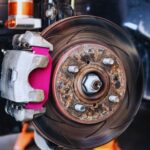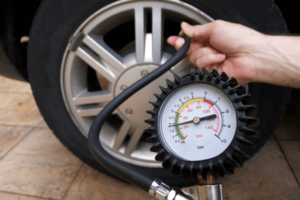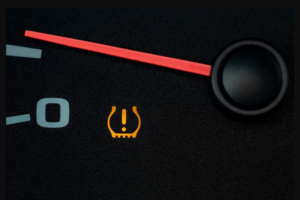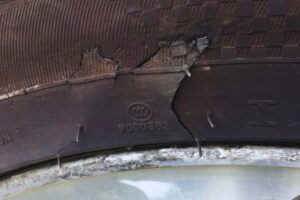When it comes to the safety of a vehicle, the condition of its tires is crucial. One important aspect of a tire’s condition is its tread depth, which is measured in 32nds of an inch.
A tire’s tread depth affects its ability to grip the road, especially in wet or slippery conditions.
One common measurement of tire tread depth is 5/32. This means that the depth of the tire’s tread pattern is 5/32 of an inch.
When someone refers to “5/32 tire wear,” they are talking about the depth of the tire’s tread. It is important to monitor tire tread depth regularly to ensure that the tires are safe to use.
Understanding Tire Tread

Tire tread is the pattern that is designed into the rubber on the surface of a tire. The tread is what makes contact with the road and provides traction and grip, especially in wet or slippery conditions. The depth of the tread pattern is measured in 32nds of an inch, with a new tire typically having a tread depth of about 10/32 to 11/32 inches (8 to 9 millimeters) 1.
Tire tread is crucial for maintaining safe driving conditions. As a tire wears down, the tread depth decreases, which can lead to decreased traction and grip on the road. It is important to regularly check the tire’s tread depth to ensure that it is not too worn down. A tread depth gauge or tread wear indicator bars can be used to measure the depth of the tread pattern 2.
When the tire’s tread wear reaches 5/32 of an inch, it is time to start thinking about replacing the tire 1. This is because at this point, the tire’s grip on the road is significantly reduced, especially in wet conditions. When the tread depth reaches 2/32 of an inch, the tire is considered legally worn out and must be replaced 3.
Wear bars, also known as tread wear indicator bars, are small raised bars that run perpendicular to the direction of the tire’s tread pattern. When the tire’s tread depth wears down to the level of the wear bars, it is a sign that the tire needs to be replaced 4.
Regularly checking the tire’s tread depth is an important part of tire maintenance. It can help prevent accidents and ensure that the vehicle is operating safely on the road.
Footnotes
Importance of Adequate Tire Tread Depth
Maintaining adequate tire tread depth is crucial for safe driving. The tread on a tire provides traction, grip, and performance on the road. Without enough tread, a tire can lose its ability to grip the road, which can result in poor braking performance, longer stopping distances, and reduced handling.
In wet weather conditions, tire tread depth is even more important. Wet roads and surfaces can cause hydroplaning or aquaplaning, which is when a vehicle loses contact with the road due to a buildup of water between the tire and the road surface. This can cause the driver to lose control of the vehicle, resulting in accidents.
The recommended tire tread depth for safe driving is 5/32 of an inch or greater. Tires with less than 4/32 of an inch of tread depth are recommended to be replaced. Once tires reach 2/32 of an inch, they are considered bald and must be replaced immediately for safety reasons.
Winter driving requires even more attention to tire tread depth. Snow, slush, and ice can cause reduced traction and grip, making it difficult to accelerate, brake, and handle the vehicle. Winter tires, all-season tires, or snow tires with deeper tread patterns are recommended for safe winter driving.
Is 5/32” a Good Tire Tread?
When it comes to tire tread depth, 5/32” is considered the minimum safe tread depth for most driving conditions. While it may not be the ideal tread depth, it is still considered good enough to provide adequate traction and grip on the road.
At 5/32”, a tire still has some life left in it, but it is recommended to start thinking about replacing it soon. Tires with this tread depth are typically good for another 5,000 to 10,000 miles, depending on the quality of the tire and the driving conditions.
It is important to note that 5/32” is not a good tread depth for wet or snowy conditions. As the tire wears down, its ability to channel water away from the tire decreases, increasing the risk of hydroplaning. In snowy conditions, the tire may not be able to provide enough traction to safely navigate the roads.
To ensure maximum safety on the road, it is recommended to replace tires when the tread depth reaches 4/32”. At this point, the tire is considered legally worn out in some states and should be replaced as soon as possible.
Measuring Tire Tread Depth

Measuring tire tread depth is an important aspect of maintaining safe driving conditions. One common measurement for tire tread depth is 5/32 of an inch. This measurement is used to determine when a tire is considered worn out and needs to be replaced.
There are several ways to measure tire tread depth. One of the most popular methods is the penny test. To perform this test, simply insert a penny into the tire groove with Lincoln’s head facing down. If the top of Lincoln’s head is visible, then the tire tread depth is less than 2/32 of an inch and the tire needs to be replaced.
Another method is the quarter test. This test is similar to the penny test, but uses a quarter instead. If the top of Washington’s head is visible, then the tire tread depth is less than 4/32 of an inch and the tire should be replaced soon.
For more accurate measurements, a tire tread depth gauge can be used. This tool measures the tire tread depth in millimeters or 32nd of an inch. It is important to measure the tread depth in several locations around the tire as tires can wear unevenly.
Here is a tire tread depth chart to help determine when it is time to replace your tires:
| Tread Depth | Description |
|---|---|
| 6/32″ | Sufficient tread depth |
| 5/32″ | Consider replacing tires if wet roads are a concern |
| 4/32″ | Seriously consider replacing tires |
| 3/32″ | Replace tires as soon as possible |
| 2/32″ | Tires are legally bald and must be replaced |
Regularly measuring tire tread depth can help ensure safe driving conditions and prevent accidents on the road.
Factors Affecting Tire Tread Wear
Tire tread wear is a natural process that occurs over time. Tires have a limited lifespan, and the amount of tread remaining on a tire can determine whether it is safe to drive on or not. There are several factors that can affect tire tread wear, including:
Improper Inflation
One of the most common causes of tire tread wear is improper inflation. When a tire is underinflated, the center of the tire will wear out faster than the edges. Conversely, when a tire is overinflated, the edges will wear out faster than the center. To prevent uneven tread wear, it is important to maintain the correct tire pressure as recommended by the manufacturer.
Wheel Misalignment
Another factor that can affect tire tread wear is wheel misalignment. When the wheels are not properly aligned, the tires will wear out unevenly. This can cause the tread to wear down faster on one side of the tire than the other. To prevent this, it is important to have the wheels aligned regularly.
Driving Style
Driving style can also affect tire tread wear. Aggressive driving, such as hard braking and rapid acceleration, can cause the tires to wear out faster. Additionally, driving at high speeds can cause the tires to heat up, which can also lead to premature wear.
Road Conditions
The road conditions that a driver encounters can also affect tire tread wear. Driving on rough roads or roads with potholes can cause the tires to wear out faster. Additionally, driving on roads that are covered in snow or ice can cause the tires to wear out faster due to the increased friction.
Dry Rot
Dry rot is another factor that can affect tire tread wear. Dry rot occurs when a tire is exposed to the elements for an extended period of time. This can cause the rubber to dry out and crack, which can lead to premature wear. To prevent dry rot, it is important to store tires in a cool, dry place when they are not in use.
Wear Bar
Tires have a wear bar that indicates when the tire has reached the end of its useful life. The wear bar is a small ridge that runs across the tire’s tread. When the tread wears down to the level of the wear bar, it is time to replace the tire. Driving on tires that have worn down to the wear bar can be extremely dangerous, as it can cause the tire to lose traction and possibly even blow out.
Choosing the Right Tires
When it comes to choosing the right tires for your vehicle, there are a few things to consider. It’s important to keep in mind that tires are the only part of your vehicle that touches the road, so it’s crucial to make sure you have the right ones for your driving needs.
One thing to consider is the type of vehicle you have. Different vehicles require different types of tires, such as all-season, winter, or performance tires. It’s important to choose a tire that is specifically designed for your vehicle to ensure the best performance and safety.
Another factor to consider is the type of driving you will be doing. If you live in an area with harsh winters, you may want to consider winter tires for better traction and handling in snowy and icy conditions. If you do a lot of highway driving, you may want to look for tires that offer a smoother ride and better fuel efficiency.
Consumer reports and ratings can also be helpful when choosing the right tires. These reports can provide valuable information about the performance, durability, and safety of different tire models. It’s also a good idea to check with a reputable tire store or auto parts store for recommendations and deals.
When shopping for tires, it’s important to keep in mind that used tires may not be the best option. While they may be cheaper, they may not provide the same level of safety and performance as new tires. It’s also important to choose a reputable tire manufacturer to ensure the quality and reliability of your tires.
Maintaining Your Tires
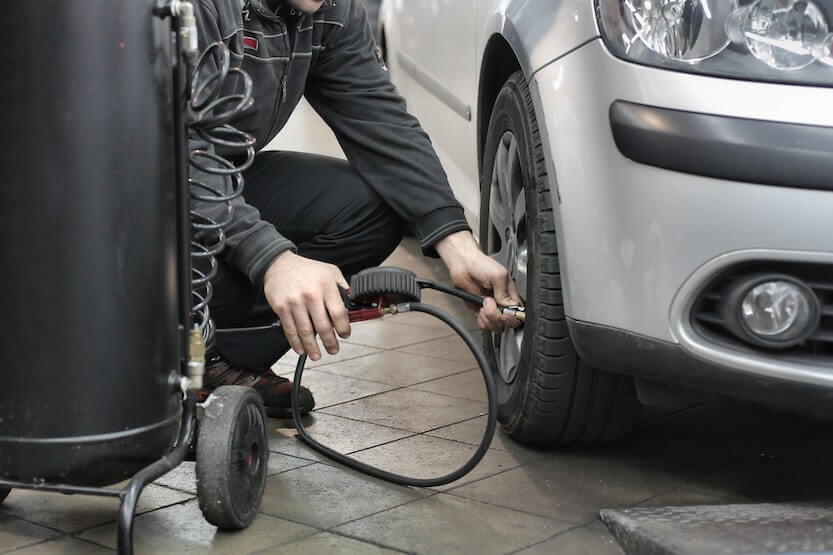
Maintaining your tires is an important aspect of ensuring your vehicle is safe to drive. Regular maintenance can help prolong the life of your tires, improve fuel efficiency, and prevent accidents. One of the most critical aspects of tire maintenance is checking the tire tread.
Checking tire tread is essential to ensure that your tires have enough rubber to grip the road properly. Tread depth is measured in 32nds of an inch, and a tire with a tread depth of 5/32″ means that the depth of the tread pattern is 5/32 of an inch. The tire’s tread is the part that makes contact with the road, and it is designed to provide traction and grip, especially in wet or slippery conditions.
To check tire tread depth, you can use the penny test. Place a penny, with Lincoln’s head upside down, into the groove between the tread ribs. If you cannot see the top of Lincoln’s head between the ribs, the tread is at least 2/32-inch deep at that location. If Abe’s whole head is visible at any groove location, you should replace that tire.
It is recommended to check the tire tread at least once a month and before long trips. Checking tire tread is especially important during the fall season when wet leaves can make the road slippery.
In addition to checking tire tread, it is also important to maintain proper tire pressure. Underinflated tires can cause excessive wear and tear, while overinflated tires can cause uneven wear and affect handling. It is recommended to check tire pressure at least once a month and before long trips.
Finally, it is essential to inspect your tires for any damage or signs of wear. Look for cuts, bulges, or other irregularities on the tire surface or sidewall. If you notice any damage, have your tires inspected by a professional.
By following these simple maintenance tips, you can help ensure that your tires are in good condition and ready to handle any corner or bump in the road.
When to Replace Tires
Tires are an essential part of any vehicle, and it’s important to know when to replace them. The usable tread on a tire is what provides traction and grip on the road, and when it wears out, the tire’s performance can suffer.
According to Consumer Reports, the general rule of thumb is to replace tires when they have worn down to 2/32 of an inch of tread depth. At this point, the tire is considered legally worn out and needs to be replaced.
However, it’s recommended to start shopping for new tires when the tread depth reaches 4/32 of an inch to ensure that you have enough time to research and purchase the right tires for your vehicle.
It’s important to note that the legal limit for tire tread depth may vary by state or country. For instance, some states in the US require tires to be replaced when they have worn down to 4/32 of an inch, while others require replacement at 2/32 of an inch. It’s always a good idea to check your local regulations to ensure that your tires are within the legal limit.
It’s also worth noting that tire life expectancy can vary greatly depending on factors such as driving habits, road conditions, and tire maintenance. According to Bridgestone Americas, the average tire tread life expectancy is around 40,000 miles. However, this can vary significantly based on the factors mentioned above.
To Summarize
In summary, 5/32 tire tread depth is an important factor to consider when it comes to tire safety. It is the minimum tread depth recommended for safe driving. Tread depth is measured in 32nds of an inch, so a tire with a tread depth of 5/32″ means that the depth of the tread pattern is 5/32 of an inch.
A tire’s tread is the part that makes contact with the road, and it is designed to provide traction and grip, especially in wet or slippery conditions. As the tread wears down, the tire’s ability to grip the road decreases, increasing the risk of accidents. This is why it is important to check your tire tread regularly and replace tires that have worn down to 4/32″ or less.
It is also important to note that tires with uneven wear patterns or damage should also be replaced, even if the tread depth is still within the recommended range. Uneven wear patterns can indicate alignment or suspension issues, which can affect the overall safety and performance of your vehicle.
In conclusion, maintaining proper tire tread depth is crucial for safe driving. Regularly checking your tire tread depth and replacing tires that have worn down to 4/32″ or less can help ensure that your vehicle is safe and performing at its best.

![Rod Bearing [What is It, How to Replace It, and Replacement Cost] rod bearing](https://roadsumo.com/wp-content/uploads/2021/05/rod-bearing-150x150.jpeg)
![CV Shaft [CV Axle Shaft Explained – And When to Replace] CV Shaft](https://roadsumo.com/wp-content/uploads/2021/12/CV-shaft-150x150.jpg)
